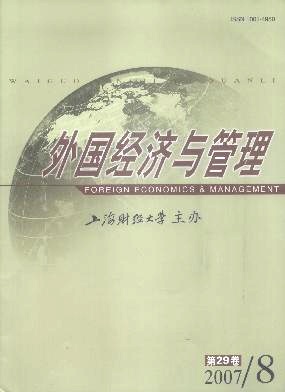柔性领导理论评介
外国经济与管理 2007 年 第 29 卷第 08 期, 页码:30 - 37
摘要
参考文献
摘要
组织的战略、结构和人力资源管理的柔性化趋势对组织的传统领导方式提出了挑战,本文在对传统领导理论进行了分析的基础上,根据近年来领导理论的新发展提出了柔性领导理论,指出以后现代人本主义为思想内核的柔性领导是组织应对管理柔性化挑战的必然产物。接着,本文从战略、团队、领导与下属关系和领导理念层面对柔性领导进行了界定,并指出了柔性领导的行为特征和行为模式。柔性领导对在组织柔性化背景下提升组织绩效起着关键作用。
[1]Henk W Volberda.Building the flexible firm:How to remain competitive[M].Oxford,England:Oxford University Press Inc.,1998.
[2]Evans,J S.Strategic flexibility for high technology manoeuvres:A conceptual framework[J].Journal of Management Studies,1991,28(1):69-89.
[3]Warner W Burke,E A Richley,and A S DeAngelis.Changing leadership and planning processes at the Lewis Research Center,NationalAeronautics and Space Administration[J].Human Resource Management,1985,24(1):81-90.
[4]Gary Yukl.An evaluation of conceptual weaknesses in transformational and charismatic leadership theories[J].Leadership Quarterly,1999,10(2):285-305.
[5]Richard L Hughes,Robert C Ginnet,and Gordon J Curphy.Leadership:Enhancing the lesson of experience[M].4th Ed.New York:McGraw-Hill,2002.
[6]Rosemary Stewart.A model for understanding managerial jobs and behavior[J].Academy of Management Review,1982,7(1):7-14.
[7]Tom J Peters.Liberation management:Necessary disorganization for the nanosecond nineties[M].New York:Alfred P.Knopf,1992.
[8]James David Thompson.Organizations in action:Social science bases of administrative theory[M].New York:McGraw-Hill,1967.
[9]Allan Calarco,and Joan Gurvis.Adaptability:Responding effectively to change[M].San Francisco,California:Jossey-Bass,2006.
[10]Marguerite Schneider.A stakeholder model of organizational leadership[J].Organization Science,2002,13(2):209-220.
[11]Gary Yukl,and Richard Lepsinger.Improving performance through flexible leadership[J].Leadership in Action,2006,26(2):3-5.
[12]Peter F Drucker.The age of discontinuity:Guidelines to our changing society[M].London:Heinemann,1969.
[13]Gary Yukl.An evaluative essay on current conceptions of effective leadership[J].European Journal of Work&Organizational Psy-chology,1999,8(1):33-48.
[14]Margaret J Wheatley.Leadership and the new science:Discovering order in a chaotic world[M].3rd Ed.San Francisco,California:Berrett-Koehler Publishers,2006.
[15]Gary Yukl.Leadership in organization[M].6th Ed.Englewood Cliffs,New Jersey:Prentice Hall,2005.
[16]David L Bradford,and Allan R Cohen.Power up:Transforming organizations through shared leadership[M].New York:John Wiley&Sons Inc.,1998.
[17]Tom J Peters,and Nancy Austin.A passion for excellence:The leadership difference[M].New York:Harper&Row Press,1985.
[18]Ervin Laszlo,and Christopher Laszlo.The insight edge:An introduction to the theory and practice of evolutionary management[M].Westport,CT:Quorum Books,1997.
[19]Charles Handy.The empty raincoat[M].London:Century Press,1995.
[20]Tom J Peters.Tom Peters essentials:Leadership[M].London,England:Dorling Kindersley Publishers Ltd.,2005.
[2]Evans,J S.Strategic flexibility for high technology manoeuvres:A conceptual framework[J].Journal of Management Studies,1991,28(1):69-89.
[3]Warner W Burke,E A Richley,and A S DeAngelis.Changing leadership and planning processes at the Lewis Research Center,NationalAeronautics and Space Administration[J].Human Resource Management,1985,24(1):81-90.
[4]Gary Yukl.An evaluation of conceptual weaknesses in transformational and charismatic leadership theories[J].Leadership Quarterly,1999,10(2):285-305.
[5]Richard L Hughes,Robert C Ginnet,and Gordon J Curphy.Leadership:Enhancing the lesson of experience[M].4th Ed.New York:McGraw-Hill,2002.
[6]Rosemary Stewart.A model for understanding managerial jobs and behavior[J].Academy of Management Review,1982,7(1):7-14.
[7]Tom J Peters.Liberation management:Necessary disorganization for the nanosecond nineties[M].New York:Alfred P.Knopf,1992.
[8]James David Thompson.Organizations in action:Social science bases of administrative theory[M].New York:McGraw-Hill,1967.
[9]Allan Calarco,and Joan Gurvis.Adaptability:Responding effectively to change[M].San Francisco,California:Jossey-Bass,2006.
[10]Marguerite Schneider.A stakeholder model of organizational leadership[J].Organization Science,2002,13(2):209-220.
[11]Gary Yukl,and Richard Lepsinger.Improving performance through flexible leadership[J].Leadership in Action,2006,26(2):3-5.
[12]Peter F Drucker.The age of discontinuity:Guidelines to our changing society[M].London:Heinemann,1969.
[13]Gary Yukl.An evaluative essay on current conceptions of effective leadership[J].European Journal of Work&Organizational Psy-chology,1999,8(1):33-48.
[14]Margaret J Wheatley.Leadership and the new science:Discovering order in a chaotic world[M].3rd Ed.San Francisco,California:Berrett-Koehler Publishers,2006.
[15]Gary Yukl.Leadership in organization[M].6th Ed.Englewood Cliffs,New Jersey:Prentice Hall,2005.
[16]David L Bradford,and Allan R Cohen.Power up:Transforming organizations through shared leadership[M].New York:John Wiley&Sons Inc.,1998.
[17]Tom J Peters,and Nancy Austin.A passion for excellence:The leadership difference[M].New York:Harper&Row Press,1985.
[18]Ervin Laszlo,and Christopher Laszlo.The insight edge:An introduction to the theory and practice of evolutionary management[M].Westport,CT:Quorum Books,1997.
[19]Charles Handy.The empty raincoat[M].London:Century Press,1995.
[20]Tom J Peters.Tom Peters essentials:Leadership[M].London,England:Dorling Kindersley Publishers Ltd.,2005.
引用本文
许一. 柔性领导理论评介[J]. 外国经济与管理, 2007, 29(8): 30–37.
导出参考文献,格式为:





 6014
6014  284
284

